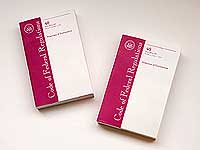Contact Pacific Southwest Waste Program
Pacific Southwest, Region 9
Serving: Arizona, California, Hawaii, Nevada, Pacific Islands, Tribal Nations
Laws & Regulations

Code of Federal Regulations
National Links
Laws and regulations are EPA's main tool for protecting the environment. Congress passes laws that govern the United States. To put those laws into effect, Congress authorizes government agencies, including EPA, to create and enforce regulations through rulemaking. Proposed and final rules are published in the Federal Register. Once promulgated, regulations are printed in the Code of Federal Regulations. To learn more about how environmental laws and regulations are created visit the Introduction to Laws and Regulations page on the EPA Headquarters site.
EPA authorizes individual States to create and enforce their own environmental regulations. Within EPA Region 9, California, Nevada, Arizona, Hawaii, and Guam are authorized. States must be at least as stringent as EPA in its regulations, but can be, and often are, more stringent. Questions regarding interpretation or implementation of environmental regulations within a specific state should be directed the specific State. The contact information for EPA Region 9 State partners are on the State and Local Partnerships page.
Resource Conservation and Recovery Act (RCRA)
The main body of law that authorized EPA to regulate solid and hazardous waste is the Resource Conservation and Recovery Act (RCRA). RCRA was established in 1976. EPA's promulgated regulations resulting from this law are codified in 40 CFR 260 to 265 and 40 CFR 266 to 299.
RCRA Policy and Guidance
EPA periodically issues policies and guidance documents that provide clarification on the implementation of the RCRA regulations. These documents are maintained in a searchable online database called RCRA Online.
